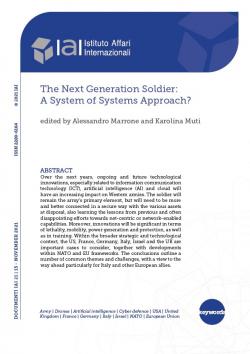The Next Generation Soldier: A System of Systems Approach?
Over the next years, ongoing and future technological innovations, especially related to information communication technology (ICT), artificial intelligence (AI) and cloud will have an increasing impact on Western armies. The soldier will remain the army’s primary element, but will need to be more and better connected in a secure way with the various assets at disposal, also learning the lessons from previous and often disappointing efforts towards net-centric or network-enabled capabilities. Moreover, innovations will be significant in terms of lethality, mobility, power generation and protection, as well as in training. Within the broader strategic and technological context, the US, France, Germany, Italy, Israel and the UK are important cases to consider, together with developments within NATO and EU frameworks. The conclusions outline a number of common themes and challenges, with a view to the way ahead particularly for Italy and other European allies.
-
Details
Rome, IAI, November 2021, 82 p. -
In:
-
Issue
21|15
Executive summary, p. 3-10
1. The Next Generation Army: Context and trends, by Karolina Muti, p. 11-16
1.1 The macro-trends in the international context
1.2 Trends in conflicts
1.3 Open questions for the next generation soldier
2. The future of individual soldier equipment and technology evolution, by Claudio Bigatti and Eugenio Po, p. 17-24
2.1 Superiority erosion
2.2 Lethality
2.3 Mobility
2.4 Power system and managing energy
2.5 Sensors and navigation
2.6 Communications
2.7 Command and control
2.8 Robotics
2.9 Protection and new materials
2.10 Human Machine Interface and synthetic training
2.11 Conclusions
3. The United States, by Scott Boston, p. 25-29
3.1 Sensors and situational awareness
3.2 Armament
3.3 Other developments
3.4 Conclusion and implications
4. France, by Bruno Lassalle, p. 30-34
5. Germany, by Ezio Bonsignore, p. 35-40
5.1 Components and functions
5.1.1 C4I
5.1.2 BST
5.1.3 WOO
5.2 Further development(s)
5.3 Concluding remarks
6. Italy, by Alessandro Marrone and Ottavia Credi, p. 41-47
6.1 Future scenarios and technological advancements
6.2 The Individual Combat System (Sistema Individuale di Combattimento)
6.3 Latest developments and cross-sector collaboration
6.4 Open issues and future objectives
7. The United Kingdom, by Nick Reynolds, p. 48-53
7.1 The evolving British approach
7.2 Basic equipment and weaponry
7.3 Command and control
7.4 Unmanned systems
7.5 Implications for the future
7.6 Conclusion
8. Israel, by Michael Shurkin, p. 54-58
8.1 Israel and the RMA
8.2 From Tsayad to Fire Weaver: The Israeli Army’s big investment in NCW
8.3 Bringing the revolution to dismounted infantry
8.4 Conclusion
9. The EU and NATO frameworks, by Ottavia Credi, p. 59-67
9.1 The EU framework
9.1.1 EDA initiatives and EDF opportunities
9.1.2 Policy debate and developments
9.2 The role of NATO: Setting standards, establishing requirements, stimulating innovation
9.2.1 NATO & military technology innovation
9.2.2 Next steps for the Alliance
10. Conclusion, by Alessandro Marrone and Michele Nones, p. 68-78
10.1 The lessons learned from military history and wishful thinking on technological innovation
10.2 The army’s unique difficulties in dealing with technologies
10.3 The complicated relation between ICT and the military
10.4 The requirement: To ensure soldier superiority against near-peer adversaries
10.5 The way ahead: A renewed System of Systems approach
10.6 Near-peer adversaries and Multi Domain Operations
10.7 The NATO and EU dimensions: Opportunities for Italy
List of acronyms, p. 79-82
Topic
Tag
Related content
-
Event01/12/2021
The Future Soldier’s Path Between Operations and Technologies
leggi tutto -
Publication29/11/2021
Next Generation Soldier. Executive summary
leggi tutto



